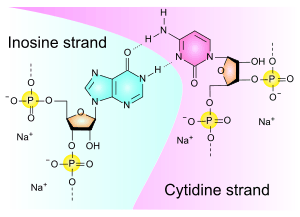Polyinosinic:polycytidylic acid
 | |
| Clinical data | |
|---|---|
| ATC code | L03AX07 (WHO) |
| Identifiers | |
| |
| CAS Number |
24939-03-5 |
| PubChem (CID) | 32744 |
| ChemSpider | none |
| Chemical and physical data | |
| Formula | (C10H10N4NaO7P)x • (C9H11N3NaO7P)x |
| | |
Polyinosinic:polycytidylic acid (usually abbreviated poly I:C) is an immunostimulant. It is used in the form of its sodium salt to simulate viral infections.[1]
Poly I:C is known to interact with toll-like receptor 3 (TLR3), which is expressed in the membrane of B-cells, macrophages and dendritic cells. Poly I:C is structurally similar to double-stranded RNA, which is present in some viruses and is a "natural" stimulant of TLR3. Thus, Poly I:C can be considered a synthetic analog of double-stranded RNA and is a common tool for scientific research on the immune system.
Chemistry
Poly I:C is a mismatched double-stranded RNA with one strand being a polymer of inosinic acid, the other a polymer of cytidylic acid.
Variants
Optimization of physicochemical properties of poly(I:C) has led to generation of derivatives that have increased stability in body fluids (such as polyICLC), or reduced toxicity through reduced stability in body fluids (such as poly(I:C12U).[2]
References
- ↑ Fortier ME, Kent S, Ashdown H, Poole S, Boksa P, Luheshi GN (2004). "The viral mimic, polyinosinic:polycytidylic acid, induces fever in rats via an interleukin-1-dependent mechanism". Am. J. Physiol. Regul. Integr. Comp. Physiol. 287 (4): R759–66. doi:10.1152/ajpregu.00293.2004. PMID 15205185.
- ↑ Naumann, Kai; Wehner, Rebekka; Schwarze, Anett; Petzold, Christiane; Schmitz, Marc; Rohayem, Jacques (2013-12-02). "Activation of Dendritic Cells by the Novel Toll-Like Receptor 3 Agonist RGC100". Clinical and Developmental Immunology. 2013: 1–11. doi:10.1155/2013/283649. ISSN 1740-2522. PMC 3878805
 . PMID 24454470.
. PMID 24454470.
A New Mesenchymal Stem Cell (MSC) Paradigm:Polarization into a Pro-Inflammatory MSC1 or anImmunosuppressive MSC2 Phenotype:Ruth S. Waterman1, Suzanne L. Tomchuck2, Sarah L. Henkle2, Aline M. Betancourt2:April 2010 | Volume 5 | Issue 4 | e10088